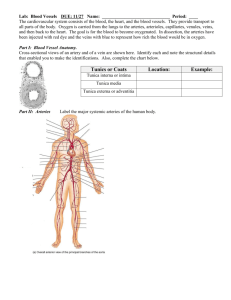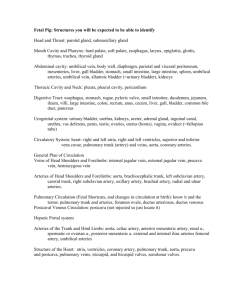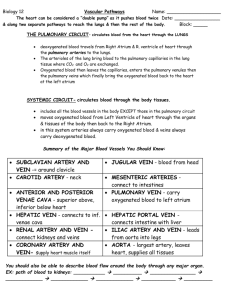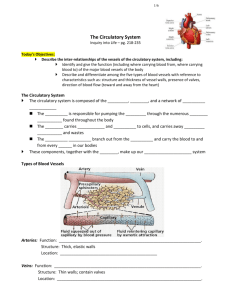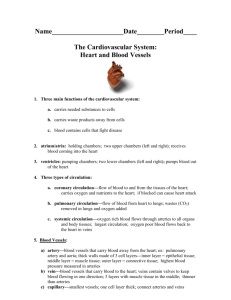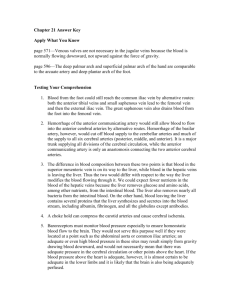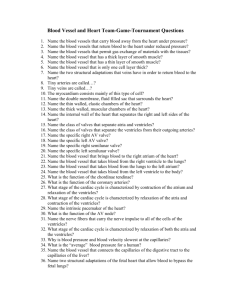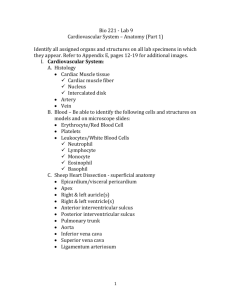Exam 4
advertisement
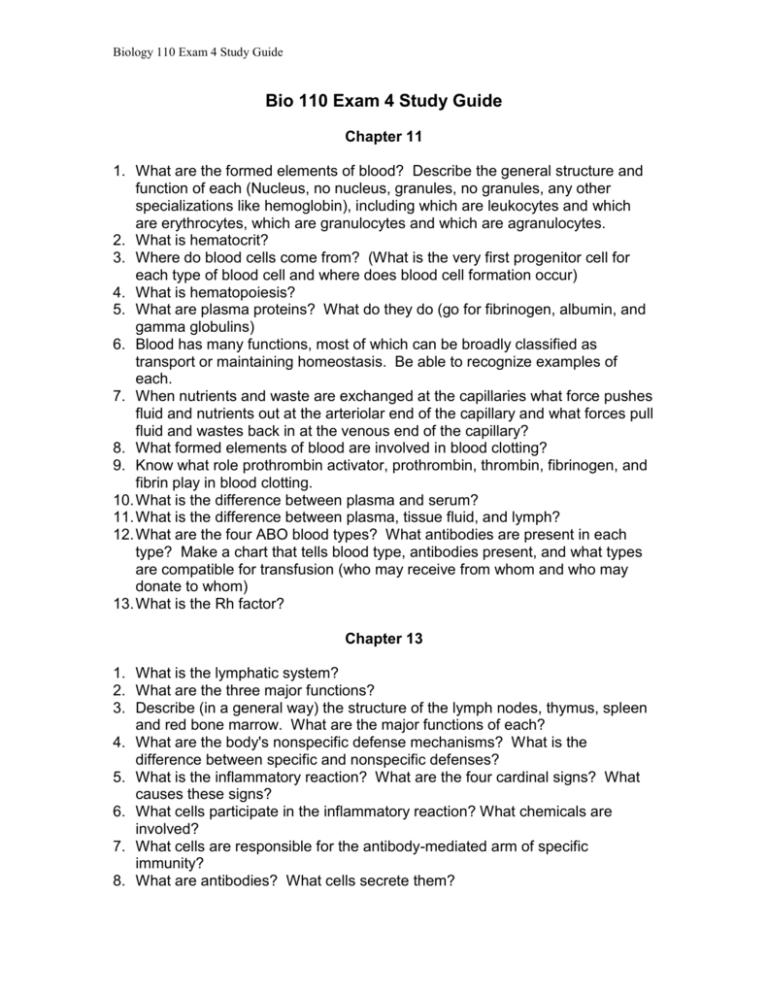
Biology 110 Exam 4 Study Guide Bio 110 Exam 4 Study Guide Chapter 11 1. What are the formed elements of blood? Describe the general structure and function of each (Nucleus, no nucleus, granules, no granules, any other specializations like hemoglobin), including which are leukocytes and which are erythrocytes, which are granulocytes and which are agranulocytes. 2. What is hematocrit? 3. Where do blood cells come from? (What is the very first progenitor cell for each type of blood cell and where does blood cell formation occur) 4. What is hematopoiesis? 5. What are plasma proteins? What do they do (go for fibrinogen, albumin, and gamma globulins) 6. Blood has many functions, most of which can be broadly classified as transport or maintaining homeostasis. Be able to recognize examples of each. 7. When nutrients and waste are exchanged at the capillaries what force pushes fluid and nutrients out at the arteriolar end of the capillary and what forces pull fluid and wastes back in at the venous end of the capillary? 8. What formed elements of blood are involved in blood clotting? 9. Know what role prothrombin activator, prothrombin, thrombin, fibrinogen, and fibrin play in blood clotting. 10. What is the difference between plasma and serum? 11. What is the difference between plasma, tissue fluid, and lymph? 12. What are the four ABO blood types? What antibodies are present in each type? Make a chart that tells blood type, antibodies present, and what types are compatible for transfusion (who may receive from whom and who may donate to whom) 13. What is the Rh factor? Chapter 13 1. What is the lymphatic system? 2. What are the three major functions? 3. Describe (in a general way) the structure of the lymph nodes, thymus, spleen and red bone marrow. What are the major functions of each? 4. What are the body's nonspecific defense mechanisms? What is the difference between specific and nonspecific defenses? 5. What is the inflammatory reaction? What are the four cardinal signs? What causes these signs? 6. What cells participate in the inflammatory reaction? What chemicals are involved? 7. What cells are responsible for the antibody-mediated arm of specific immunity? 8. What are antibodies? What cells secrete them? Biology 110 Exam 4 Study Guide 9. What do B cells do when stimulated by antigen? 10. What is an antigen? 11. What is the variable region of an antibody responsible for? 12. Recognize the antibody types and what they do. 13. What are two types of T cells? What do they do? 14. Which arm of specific immunity do T cells participate in? (be careful, there is a trick question waiting to happen here: T4 cells, or helper cells actually can participate in both) 15. What is the difference between active and passive immunity? Recognize examples of naturally acquired active, naturally acquired passive, artificially acquired active and artificially acquired passive immunity. 16. How does the immune system cause allergies, tissue rejection, autoimmune diseases, and immune deficiency? 17. What are some autoimmune diseases? 18. What are SCID and AIDs? Chapter 12 1. Describe the structure of the heart including chambers and valves. 2. What keeps the AV valves from blowing back into the atria when the ventricles contract? 3. Trace the path of blood in the pulmonary circuit as it travels from and returns to the heart. 4. Describe the cardiac cycle. What does systole mean? What does diastole mean? Can the atria be in systole while the ventricles are in diastole? Can the opposite happen? Can atria and ventricle be in systole at the same time? Can atria and ventricles be in diastole at the same time? 5. What causes the heart sounds? 6. What are the causes of a heart attack? 7. Describe the different types of blood vessels in the body. Compare an contrast their structure and function. Do arteries always carry oxygenated blood? Do veins always carry deoxygenated blood? If not what are the exceptions? What is a better definition of arteries and veins then? 8. Trace the path of blood from the mesenteric arteries to the aorta, indicating which of the vessels are in the systemic circulation and which are in the pulmonary circulation. 9. What is blood pressure? 10. What type of blood vessel has the highest blood pressure? 11. Which vessel has the lowest blood pressure? 12. Which type of blood vessel has the lowest velocity? Why? Is this a good thing? Explain. 13. What assists the return of venous blood to the heart? Arteries to know for the exam: Aorta Pulmonary Trunk, pulmonary arteries Biology 110 Exam 4 Study Guide Coronary arteries Common carotid arteries Subclavian artery Brachial artery Ulnar artery Radial artery Renal artery goes to kidneys from aorta Hepatic artery goes to liver from aorta Mesenteric arteries go to intestines from aorta Common iliac artery Femoral artery Popliteal arterial Anterior and posterior tibial arteries Veins to know for the exam: Inferior and superior vena cava Internal and external jugular veins Subclavian vein Radial vein Ulnar vein Hepatic vein Renal vein Common iliac vein Femoral vein Popliteal vein Anterior and posterior tibial veins Chapter 14 1. 2. 3. 4. What is the general function of the respiratory system? What are the four parts of respiration? Which part uses oxygen and produces carbon dioxide? List the parts of the respiratory tract. What are the special functions of the nasal cavities, larynx, and alveoli? 5. What are the steps in inspiration and expiration? How do the pleura aid inspiration? What do changes in air pressure in the thoracic cavity have to do with inspiration and expiration? 6. How is breathing rate controlled? 7. Define the lung volumes. What is dead space? 8. What drives gas exchange? 9. How is carbon dioxide carried in the blood? 10. How is oxygen carried in the blood? 11. What does respiration have to do with pH of body fluids? 12. Describe some respiratory tract infections. 13. What are emphysema and pulmonary fibrosis? 14. What is the most common cause of lung cancer? Biology 110 Exam 4 Study Guide 15. Why is the incidence of lung cancer rising among women? Chapter 15 1. List the digestive tract organs in the order encountered from the mouth to the anus. 2. What are the accessory organs of digestion? 3. What is digestion? What is the purpose? 4. Which are the wisdom teeth? 5. What does fluoride treatment strengthen? 6. What does the pharynx connect to? 7. What is a bolus? 8. What is chyme? 9. What are rugae? Where are rugae found? 10. What is peristalsis? What does it do? 11. Where is HCl found? What does it do? 12. What is heartburn is due to? 13. Where are gastric glands found? What do they secrete? 14. What is the function of the small intestine? 15. Where are villi found? What is their purpose? 16. What are lacteals? What is their function? 17. Why are the pancreas and liver referred to as accessory organs? 18. What nutrients do enzymes secreted by the pancreas act on? 19. Is the secretion of pancreatic juice an endocrine function or exocrine function? 20. Which is the largest gland in the body? 21. What is bile? What does it contain? What does it do? What is emulsification? 22. What are bile pigments? 23. What nutrient is emulsified before digestion begins? 24. What is the function of the gallbladder? Where is the gallbladder located? 25. What are the functions of the liver? 26. Where are pancreatic juice and bile released? 27. What is jaundice? What causes it? 28. What is the function of the large intestine? 29. What is the function of bacteria in the large intestine? 30. What dietary components can help prevent constipation? 31. What digestive organ are appendicitis and diverticulosis associated with? 32. Where does chemical digestion begin? Where does mechanical digestion begin? 33. Where does the hepatic portal vein carry nutrients to? 34. What is the immediate energy source for the body? 35. Which nutrients are essential in the diet? 36. Which organs of the digestive tract lack digestive enzymes? Chapter 16 Biology 110 Exam 4 Study Guide 1. 2. 3. 4. 5. 6. 7. 8. What are the excretory organs? What might be found in excretory waste? Where are the kidneys located? In which sex is the urethra part of the reproductive system? The ureter carries urine from the: Which kidney structure provides urine? Of what does the nephron consist? What is meant by nitrogenous waste? What compounds are included in this category? 9. Which is formed from the breakdown of amino acids? 10. Which part of a nephron is part of the circulatory system? 11. Why are salts excreted? 12. Does tubular reabsorption occur by active transport or passive transport ? 13. In diabetes mellitus what happens to the high levels of blood glucose when the blood is filtered at the kidney? 14. What is the function of ADH? From where is it secreted? 15. What are diuretics? What do they do? 16. What is the function of aldosterone? Where is it produced? 17. What cells secrete renin? 18. Do the kidneys control blood volume, regulate the electrolyte balance of blood, or control acid-base balance? 19. What happens to excess uric acid?
